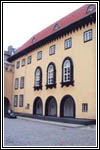 |
Vol 0, No 26
22 March 1999 |
|
|
 T H E A M B E R C O A S T:
T H E A M B E R C O A S T:
Assessing Estonia's New Government Mel Huang With the 7 March Riigikogu (Parliament) elections long over, the task of building a government is at hand. The success of the three centre-right lists of the United Opposition - Pro Patria Union, Reform Party, and the Moderates - in gaining 53 seats out of 101 total ensured the formation of a majority government. The three groups signed a co-operation memorandum on 31 December 1998 to work in a majority coalition government, and they got their wish. Though it is a three-party coalition and the philosophies naturally differ among the groups, the new coalition will easily be more stable than previous governments over the past few years. There was surprisingly little argument over the prime ministerial candidate among the three parties, despite the Pro Patria Union winning only 829 more votes (total of 77,917 and 18 seats) nation-wide than the Reform Party (77,088 and 18 seats), followed by the Moderates (73,630 and 17 seats). Following the pre-election agreement, the party with the most votes names the prime ministerial candidate. The trilateral group also agreed to split the fifteen cabinet seats evenly. Though at the time of writing, the list is not yet official, there is little reason to believe it would change. Therefore, Mart Laar, leader of the Pro Patria Union, returns to the prime minister's seat after losing a vote-of-confidence in 1994. At the time, the youngest prime minister in Europe (32 when he took office) pushed Estonia through some of the toughest set of reforms throughout Central and Eastern Europe and placed Estonia on its current path of success. Though some worried about his poor rapport with Moscow, Laar has a solid reputation in the West. For one, he is loved by tax-reform campaigners in the United States for his championing of the flat tax system enjoyed in Estonia. Laar is assembling a solid team in his cabinet, especially in foreign relations. Returning to the foreign ministry portfolio is Toomas Hendrik Ilves (of the Moderates), the man credited with selling Estonia to the EU and gaining the coveted front-running group status. Lauded by The Economist as well as others, Ilves will also be able to turn his attention to his main expertise: NATO. Joining him on that team is the return of Juri Luik as defence minister. Luik is a phoneme of sorts, gaining his first ministerial job at the age of 26 and moving into his later defence and foreign ministry portfolios at the ripe old age of 27. Having served for the past few years as ambassador to the Benelux countries, as well as NATO, the return of this NATO expert to the defence minister's post gives Estonia a solid basis for its never-ending pursuit of NATO membership. This combined team of Laar, Ilves and Luik are well-known throughout Europe and the North Atlantic sphere, thus foreign policy should be in safe hands. After some bargaining, Reform Party leader Siim Kallas took the finance ministry portfolio. Originally destined for a return to the foreign minister's job, Kallas at the end agreed to the less prestigious position but one closer to his heart. Being the former head of the central bank and 'father' of the kroon (Estonia re-established its currency in 1992, the first to leave the ruble zone), this area would be second nature for him and his liberal economic policies. Plus, with an ongoing appeal by prosecutors over his acquittal in a corruption trial a few weeks ago, the lower-profile would serve the government better on the PR front. One surprise is the introduction of political novice Juri Mois as interior minister. Mois was among the original founders of regional banking leader Hansapank and served as its chairman until last year's Swedish take-over of the bank. Originally touted as a possible finance minister, Mois now takes on the most difficult job in the cabinet. He will have to deal with the unwieldy departments within the ministry's jurisdiction, all requiring overhaul and major reform: the police, prison authority, citizenship and migration board, among many others. The rest of the 15 cabinet spots also boast strong candidates. Several are also former ministers, such as Justice Minister Mart Rask reassuming his old role. Toivo Jurgenson of Pro Patria Union will have a difficult job, as he has to shut down the Ministry of Transport and Communications - due to merge with the Ministry of Economics. Looking at this prospective list of cabinet ministers, Estonia should have a solid team leading it into the next millennium. How appropriate, that several years ago Mart Laar was chosen to be the author of Estonia's millennium message - note this was during his 'unpopular' days as a former PM. Maybe some predicted the return of Laar before any of us figured. Mel Huang, 22 March 1999
|
|
![]()
Copyright (c) 1999 - Central Europe Review and Internet servis, a.s.
All Rights Reserved